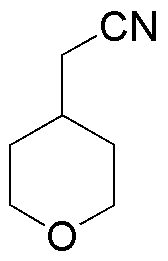(Tetrahydropyran-4-yl)acetonitrile is widely utilized in research focused on
- Synthetic Organic Chemistry: This compound serves as a versatile building block in the synthesis of various organic molecules, facilitating the development of new pharmaceuticals and agrochemicals.
- Drug Development: It is employed in the pharmaceutical industry for the creation of novel drug candidates, particularly in the design of compounds with improved bioavailability and efficacy.
- Material Science: The chemical is used in the formulation of advanced materials, including polymers and coatings, which benefit from its unique structural properties.
- Biochemical Research: Researchers utilize this compound in biochemical assays and studies to explore its interactions with biological systems, aiding in the understanding of metabolic pathways.
- Environmental Chemistry: It plays a role in the development of environmentally friendly solvents and reagents, contributing to sustainable practices in chemical manufacturing.
General Information
Properties
Safety and Regulations
Applications
(Tetrahydropyran-4-yl)acetonitrile is widely utilized in research focused on
- Synthetic Organic Chemistry: This compound serves as a versatile building block in the synthesis of various organic molecules, facilitating the development of new pharmaceuticals and agrochemicals.
- Drug Development: It is employed in the pharmaceutical industry for the creation of novel drug candidates, particularly in the design of compounds with improved bioavailability and efficacy.
- Material Science: The chemical is used in the formulation of advanced materials, including polymers and coatings, which benefit from its unique structural properties.
- Biochemical Research: Researchers utilize this compound in biochemical assays and studies to explore its interactions with biological systems, aiding in the understanding of metabolic pathways.
- Environmental Chemistry: It plays a role in the development of environmentally friendly solvents and reagents, contributing to sustainable practices in chemical manufacturing.
Documents
Safety Data Sheets (SDS)
The SDS provides comprehensive safety information on handling, storage, and disposal of the product.
Product Specification (PS)
The PS provides a comprehensive breakdown of the product’s properties, including chemical composition, physical state, purity, and storage requirements. It also details acceptable quality ranges and the product's intended applications.
Certificates of Analysis (COA)
Search for Certificates of Analysis (COA) by entering the products Lot Number. Lot and Batch Numbers can be found on a product’s label following the words ‘Lot’ or ‘Batch’.
*Catalog Number
*Lot Number
Certificates Of Origin (COO)
This COO confirms the country where the product was manufactured, and also details the materials and components used in it and whether it is derived from natural, synthetic, or other specific sources. This certificate may be required for customs, trade, and regulatory compliance.
*Catalog Number
*Lot Number
Safety Data Sheets (SDS)
The SDS provides comprehensive safety information on handling, storage, and disposal of the product.
DownloadProduct Specification (PS)
The PS provides a comprehensive breakdown of the product’s properties, including chemical composition, physical state, purity, and storage requirements. It also details acceptable quality ranges and the product's intended applications.
DownloadCertificates of Analysis (COA)
Search for Certificates of Analysis (COA) by entering the products Lot Number. Lot and Batch Numbers can be found on a product’s label following the words ‘Lot’ or ‘Batch’.
*Catalog Number
*Lot Number
Certificates Of Origin (COO)
This COO confirms the country where the product was manufactured, and also details the materials and components used in it and whether it is derived from natural, synthetic, or other specific sources. This certificate may be required for customs, trade, and regulatory compliance.


